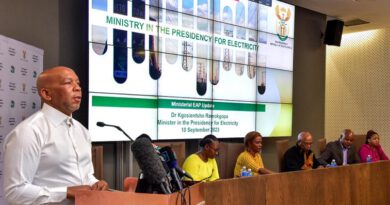‘Nearly R200bn strategic infrastructure projects are under construction’
SA’s infrastructure backlog appears to be getting some of the attention it needs.
Some 48 strategic infrastructure projects worth R193.4 billion are currently under construction, and projects worth R87.4 billion in the procurement phase, according to Infrastructure SA (ISA), which was established by cabinet in May 2020 to accelerate infrastructure development.
These projects are expected to create more than 421 000 jobs, according to ISA, which operates under the Ministry of Public Works and Infrastructure.
There are 328 projects in the ISA pipeline, most of which relate to energy, human settlements, transport, social infrastructure and water.
While this is a drop in the ocean compared with the R6.58 trillion envisaged in terms of the National Development Plan 2030, there are promising signs of gathering momentum.
One of the projects being piloted by government is putting its massive property portfolio to better use.
“The government is looking at refurbishing and leasing out old buildings, and putting government buildings back into the private space,” said Alvino Wildschutt-Prins, manager for Infrastructure Pipeline Management, speaking at the Asset Owners Forum South Africa’s (AOFSA’s) first anniversary gathering last week.
Government owns 4.7 million hectares or 4.5% of the country’s land area, and has about 90 000 facilities with a net asset value of R134.5 billion, or 33.9 million square metres that could be put to use.
However, nearly two-thirds of that property portfolio is rated as being in fair to very poor condition.
So-called catalytic projects, worth more than R300 billion, have been identified. These include the production of green hydrogen by Sasol for use in sustainable aviation fuel and the greening of industry, and the Hydrogen Valley Project, led by Anglo Platinum, aimed at creating a green hydrogen corridor with several hydrogen-related industrial, construction and transport projects.
Investment spending in South Africa fell from an average of almost 30% of GDP in the early 1980s to about 16% by the early 2000s. “In effect, South Africa has missed a generation of capital investment in roads, rail, ports, electricity, water, sanitation, public transport and housing. To grow faster and in a more inclusive manner, the country needs a higher level of capital spending,” says the National Development Plan 2030.
Read:
Engineering body issues dire warning over collapsing public infrastructure
Ford forced to truck its export vehicles to Durban port
SA sets sights on R4.3trn in hydrogen investment
Gross fixed capital formation (% of GDP) South Africa
Source: World Bank. World Bank national accounts data, and OECD National Accounts data files.
The National Development Plan 2030 calls for gross fixed capital formation to return to about 30% by 2030, with public sector investment accounting for 10% of GDP.
The lack of reliable energy is one of the key bottlenecks to be addressed.
The Infrastructure Investments Review Committee (IIRC) has approved some 16 projects in the energy space to address the country’s critical energy shortage, which should encourage broader investment in other areas of the economy.
Wildschutt-Prins said the Infrastructure Fund, set up by President Cyril Ramaphosa in 2018 and run by the Development Bank of Southern Africa (DBSA), currently has R5.9 billion in projects at an advanced stage, including the building of 320 000 social housing units, and the upgrade and refurbishment of water supply at Olifantspoort and Ebenezer in Limpopo.
Asset Owners Forum mobilises R5.7 billion
“Since its establishment, AOFSA members have collectively committed R5.7 billion to infrastructure over the past 24 months. This has comfortably exceeded the R860 million target that we set out to achieve and is an indication of our members’ commitment to the objectives of the forum,” said Musa Mabesa, AOFSA chair and principal executive officer of the Government Employees Pension Fund (GEPF).
AOFSA comprises 13 of SA’s largest pension funds.
“The forum does not make investment decisions. When considering the potential infrastructure projects, funds need to go through their own due diligence and governance process, and make their own investment decisions,” said Mabesa.
USAID facilitated the forum’s infrastructure programme, which originally considered 64 projects for review.
“We are shaping the future of South Africa,” he said. “Our investment targets for this period since launch has been surpassed. The multiplier effects of infrastructure projects on socio-economic development and growth are well documented, which gives us considerable hope for the future.
“We are well on our way to achieving our goal of increasing the amounts invested by pooling assets from large and small retirement funds into in long-term projects. All retirement funds within South Africa are welcome to join us on this journey,” said Mabesa.
Construction mafia
As an aside, asked what the government is doing to address the intrusion of the so-called construction mafia on construction sites, Wildschutt-Prins said the mafia tends to target public sector rather than private sector projects, though instances of disruption have dropped in recent months since the ISA had appointed social facilitators to work with different stakeholders.
Source: moneyweb.co.za



